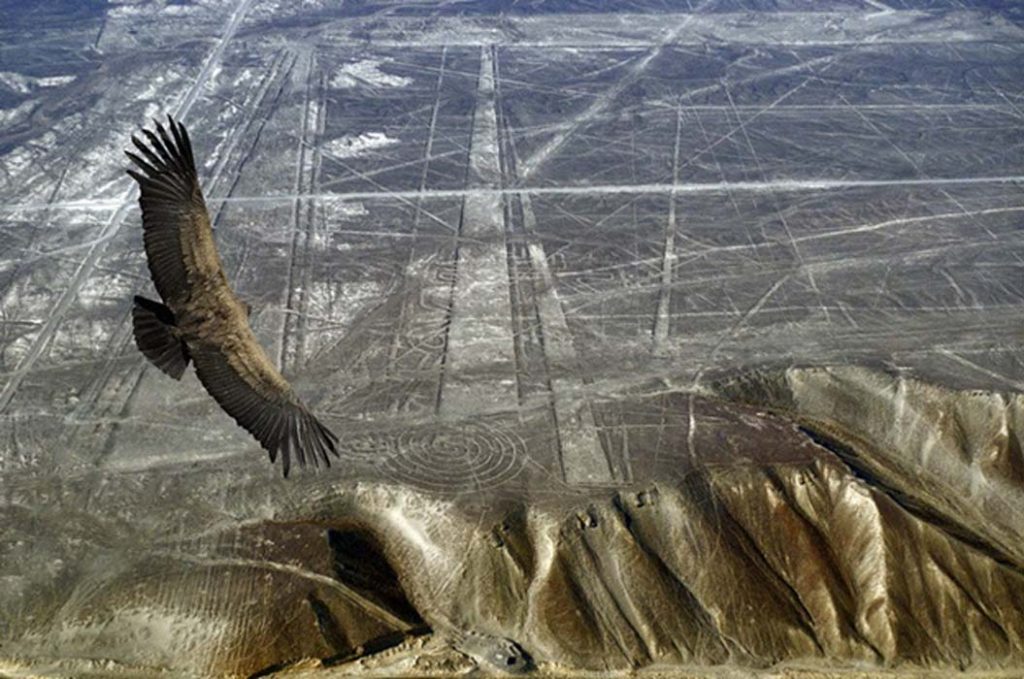Introduction
The Nazca lines, an intricate network of ancient geoglyphs etched into the arid landscape of Peru, continue to bewilder researchers and enthusiasts alike, despite decades of meticulous examination. While archaeologists have made strides in understanding how these enigmatic lines were created, the fundamental question of why they were made remains shrouded in uncertainty. Recent conjectures propose a connection between the lines and fertility rituals linked to water availability. However, there exists an intriguing alternative perspective that perceives the straight, lengthy lines as runways for ancient airports. Despite this speculation, the dearth of compelling evidence hampers the substantiation of this proposition.
The Nazca Designs: A Glimpse into the Past

The Nazca designs encompass an array of motifs, from identifiable animals like spiders and monkeys to more abstract configurations. Some of these figures are comprised solely of straight lines, often situated atop hills and seemingly terminating at cliff edges. Unlike the distinct figurative forms, these straight-line patterns bear an uncanny resemblance to runways in terms of their length and straightness. This visual parallel has led some fringe theorists to posit that these lines served as ancient airstrips or airports. There’s even speculation that lines on elevated terrain were purposefully constructed for launching gliders.
The Dueling Theories: Alien Visitation vs. Advanced Civilization

Two primary camps advocate the runway interpretation of these Nazca lines – one attributing their creation to visiting extraterrestrial beings and the other suggesting advanced flight technology by the Nazca civilization itself. Advocates of both viewpoints point to the Tolima artifacts, gold figurines that occasionally bear a resemblance to jet planes. This resemblance fuels the contention that ancient South Americans either possessed flight technology or encountered it from external sources, possibly ancient aliens.
The Alien Hypothesis: Gaps in Evidence

While the notion of extraterrestrial influence is captivating, it rests on shaky ground due to the lack of substantial supporting evidence. The absence of crashed spaceships, unique alloys, or unmistakably non-terrestrial materials raises doubts about alien visitation. Additionally, the delicate precision with which the lines were crafted – involving the meticulous removal of topsoil – contradicts the notion of a spaceship landing that would likely disrupt this fragile composition.
Occam’s Razor: The Nazca People as Creators

A more plausible explanation emerges when examining the capabilities of the Nazca people themselves. Experimental archaeology has demonstrated that teams could craft such lines using the technology available during their era. Occam’s razor suggests that the Nazca culture, residing in the vicinity, was proficient enough to conceive and construct these designs. In contrast, evidence supporting extraterrestrial involvement remains conspicuously absent.
Skepticism and Interpretation

While the theory of advanced flight technology is intriguing, it’s important to acknowledge the limitations of interpretation. The Nazca perspective on art and design may have differed significantly from ours. For instance, seemingly mechanical representations could merely be coincidental resemblances, akin to modern archaeologists dubbing ancient artifacts with contemporary names. This context-driven interpretation extends to the Nazca designs as well.
Beyond the Lines: Ambiguity Persists
The abundance of straight lines in history doesn’t unequivocally designate them as runways. Consequently, the extended straightness of the Nazca lines doesn’t unequivocally substantiate the runway hypothesis. Both the perceived runways and the geoglyphs resembling mechanical elements remain too ambiguous on their own to firmly conclude that the Nazca civilization was technologically advanced beyond its time.
The Elusive Evidence: Quest for Flight Technology

Presently, no concrete evidence supports the presence of airplanes or flying machines crafted by the Nazca people. The cryptic lines and symbols, which modern observers sometimes interpret as mechanical, lack substantive proof of crashed aircraft or airplane components. The absence of nearby structures resembling hangars or airports further underscores the absence of substantial evidence.
Clues from the Past: The Quimbaya Artifacts
In support of the advanced technology theory, proponents point to the Quimbaya artifacts. The Quimbaya culture fashioned numerous gold artifacts portraying animals, some of which sport fins and delta-shaped wings. These features have led some to speculate that these representations could be ancient depictions of airplanes.
Conclusion
The Nazca lines, an enduring enigma, continue to captivate our imagination. While theories of alien involvement and advanced flight technology by the Nazca people persist, the weight of evidence remains skewed toward the latter. The absence of conclusive proof for extraterrestrial contact necessitates a more grounded approach. Ultimately, these lines symbolize not only the mysteries of the past but also the complexities of interpretation.



